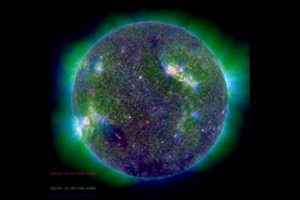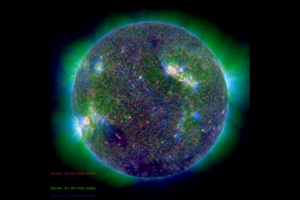And it really does resemble a big, luminous, writhing ball of colorful ice cream (though what "writhing ice cream" is, I'm not certain; use your imagination).
Kept up-to-date by an Internet feed from Lockheed's Solar and Astrophysics Lab in Palo Alto, the display at Chabot is showing visitors visions of our Sun unlike anything that has preceded it.
SDO was launched last year, and since then has been capturing high resolution, multi-wavelength visible and extreme-ultraviolet imagery at very frequent intervals. Its array of extreme-ultraviolet imaging telescopes (the "AIA" instrument) captures the energetic UV emissions from the Sun's hot atmosphere, revealing in extraordinary detail the Sun's busy and complicated magnetic activity: hot active regions, solar flares, coronal mass ejections, magnetic loops and arcs, and prominences.
The various images taken at the different wavelengths are blended together into an exquisitely colorful, nuanced, and delicious movie of a day of the life of the Sun (and with about 24 hours of images compressed into a few seconds, you really can see a day of its life!).
SDO was built to give us a much more detailed picture of what makes the Sun tick as we enter the 24th Solar Cycle, which started in the last few years. A Solar Cycle is the period over which solar magnetic activity rises, climaxes, and falls again. Solar Cycle 1 started around the year 1755, and in the intervening centuries we've been through 23 cycles, which have averaged pretty reliably at about 11 years long each. (Solar Cycle 1, by the way, wasn't the first; that's just when they started numbering them, shortly after their discovery.)
Over the past few years, the Sun has been pretty quiet; our solar telescopes at Chabot have seen few sunspots (markers of regions of magnetic activity), and even the Sun's energetic atmosphere has been more or less quiescent, with only the occasional prominence or filament ("clouds" of cooler gases confined by solar magnetic fields) visible through special "Hydrogen-Alpha" filters.
But that's all changing now. Through our visible light telescopes, beautiful groups of sunspots have started making regular appearances, crossing the Sun's face as the Sun slowly rotates in space. Sunspots appear darker than the surrounding visible surface of the Sun, being a couple of thousand degrees cooler—but they are still quite bright; if we blocked off all of the Sun's light except that shining from an average sized sunspot (average meaning Earth-sized), it would appear as bright as the Full Moon on a clear night.
Through our Hydrogen-Alpha telescopes, prominences and filaments are becoming far more numerous, and more amazingly huge than over the past few years of minimal solar activity.
And the SDO movie display is revealing to us a great deal of activity—hot spots of magnetic mayhem spouting from within the Sun and surging into the atmosphere. With the peak of solar activity of Solar Cycle 24 expected to occur sometime in 2013, we're in for at least a couple of years of ever-increasing fireworks on the Sun, with all the related space weather storms, auroral light shows, and cell phone interference that comes with it.
What flavors of Sun are we serving then? Well, we have vanilla of course, served up by our little Sunspotter visible light telescopes—vanilla is my favorite ice cream…. And the Hydrogen-Alpha scopes scoop burgundy cherry and bubblegum in nice spoon-sized portions (bubblegum not your taste? Try some of ours…).
Imagery from the old and reliable SOHO satellite solar observatory offer blueberry, key lime, butter brickle, and strawberry. And the new SDO movies provide our newest menu items: mint chocolate chip, pistachio and black cherry, rainbow sherbet, and blueberry walnut banana supreme…or whatever unusual and mindboggling combination that comes to your mind when you look at them!
Come on up to Chabot for a taste! Napkins not provided….
37.8148 -122.178
 Extreme ultraviolet composite solar image from NASA's SDO.
Extreme ultraviolet composite solar image from NASA's SDO. 